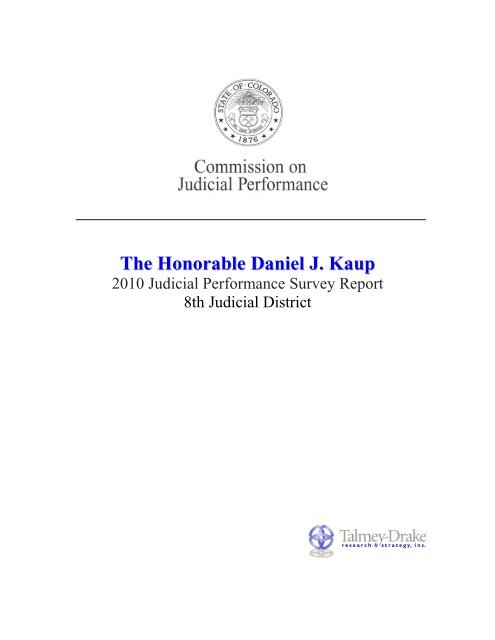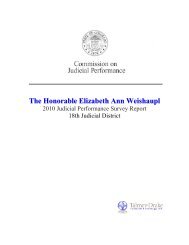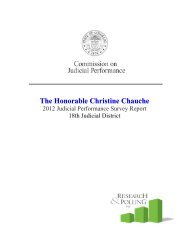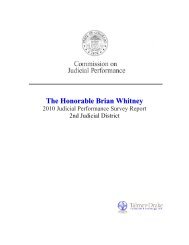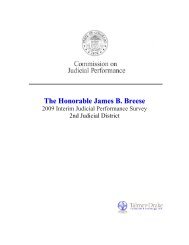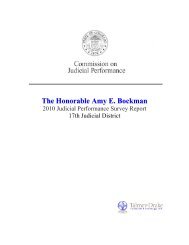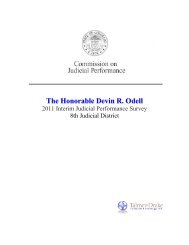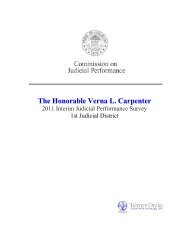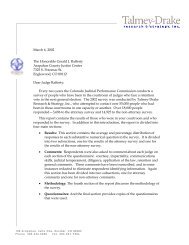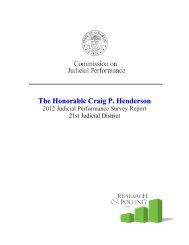The Honorable Daniel J. Kaup - Mountain Legal â Colorado ...
The Honorable Daniel J. Kaup - Mountain Legal â Colorado ...
The Honorable Daniel J. Kaup - Mountain Legal â Colorado ...
Create successful ePaper yourself
Turn your PDF publications into a flip-book with our unique Google optimized e-Paper software.
State of <strong>Colorado</strong> LogoCOMMISSION ON JUDICIAL PERFORMANCE<strong>The</strong> <strong>Honorable</strong> <strong>Daniel</strong> J. <strong>Kaup</strong>2010 Judicial Performance Survey Report8th Judicial District
Summary of ResultsAttorneys assigned Judge <strong>Daniel</strong> J. <strong>Kaup</strong> an overall average grade 1 of 2.93, and nonattorneysassigned Judge <strong>Kaup</strong> an overall average grade of 3.67 resulting in a combinedgrade of 3.30. <strong>The</strong> average combined grade for all district judges, including those noteligible to stand for retention in 2010, was 3.48. <strong>The</strong> combined average grade iscomputed as the total of the overall average from the attorney survey plus the overallaverage from the non-attorney survey, divided by two.Judge <strong>Kaup</strong> Average GradesCombined Attorney Non-attorneyOverall Grade 3.30 2.93 3.67Sample Size - 53 227Table 1<strong>The</strong> results presented in this report are based on data collected in 2005, 2007, 2008 and2009. (See Methodology section for description of sampling process.) Table 2 showsJudge <strong>Kaup</strong>’s overall average grades for each of these years.Judge <strong>Kaup</strong> Average Grades by YearCombined OverallAverage Grade 2Attorney OverallAverage GradeNon-Attny OverallAverage Grade2005 2007 2008 2009 2005 2007 2008 2009 2005 2007 2008 2009Overall Grade 3.39 3.19 3.20 3.39 3.15 2.73 2.78 3.87 3.63 3.64 3.62Sample Size - - - - 5 15 6 27 38 54 74 61Table 21 <strong>The</strong> overall average grade for the attorney and non-attorney surveys are computed by summing the averagegrade for each A through F question and dividing by the number of questions. See the tables in each of the surveysections.2 District judges who were appointed between 2005 and 2009 will not have sample for the years prior to theirappointment. In the tables for those years with no sample, the sample size will be shown as 0, and the overallaverage cells will be blank. This will also be true for a few judges who had no attorney sample even though theywere on the bench that year.2010 Judicial Performance Survey Report1
Due to sending questionnaires to all jurors—not just a sample—and their much higherresponse rate than other non-attorneys surveyed, the percentage of jurors in the districtjudge sample of the non-attorney survey is 61%. Moreover, jurors tend to grade judgesmuch higher than non-jurors. <strong>The</strong> average juror overall average grade for districtjudges was 3.86, while the overall average grade awarded by non-jurors was 3.28. <strong>The</strong>effect of this is that judges with a higher percentage of jurors in their sample tend tohave higher average grades in the non-attorney survey than those judges with a smallpercentage of jurors. <strong>The</strong> number of jurors in a judge’s sample is, of course, closelyrelated to the number of jury trials the judge presides over.<strong>The</strong> table below shows Judge <strong>Kaup</strong>’s non-attorney results broken out by jurors and nonjurors.It also shows the overall average juror and non-juror grades for all districtJudge <strong>Kaup</strong> Average Grade by Juror/Non-jurorJurorsNon-JurorsOverall Grade 3.88 3.45Percent of Sample 49% 51%Sample Size 112 115District Judge Average 3.86 3.28Table 3Judges. Table 3 allows one to compare Judge <strong>Kaup</strong>’s juror and non-juror grades withthe all district judge averages to better ascertain if the judge is seen as performingrelatively well or relatively poorly among these two subgroups.2010 Judicial Performance Survey Report2
Survey of Attorneys RegardingJudge <strong>Daniel</strong> J. <strong>Kaup</strong>(Sample Size 53)
Survey of Attorneys Regarding Trial JudgesJudge <strong>Daniel</strong> J. <strong>Kaup</strong>Sample Size = 53A B C D Fail DK/NAAverage<strong>Daniel</strong> J. <strong>Kaup</strong>All DistrictJudges1. Case Management:1a. Promptly issuing a decision on the case after trial. 26% 25% 17% 11% 2% 19% 2.77 3.421b. Maintaining appropriate control over proceedings. 38% 42% 11% 4% 4% 2% 3.08 3.431c. Promptly ruling on pre-trial motions. 21% 34% 28% 9% 0% 8% 2.71 3.251d. Setting reasonable schedules for cases. 35% 42% 12% 8% 0% 4% 3.08 3.252. Application and Knowledge of Law:Overall Case Management2.91 3.342a. Being able to identify and analyze relevant facts. 29% 40% 19% 10% 2% 0% 2.85 3.302b. Basing decisions on evidence and arguments. 32% 36% 19% 8% 4% 2% 2.87 3.132c. Willing to reconsider error in fact or law. 19% 23% 15% 13% 2% 28% 2.61 3.092d. Issuing consistent sentences when the circumstances aresimilar.21% 44% 16% 2% 2% 14% 2.92 3.163. Communications:Overall Application and Knowledge of Law2.81 3.173a. Making sure all participants understand the proceedings. 49% 30% 13% 6% 0% 2% 3.25 3.553b. Providing written communications that are clear, thorough 27% 30% 19% 16% 5% 3% 2.58 3.32and well reasoned.4. Demeanor:Overall Communications2.92 3.444a. Giving proceedings a sense of dignity. 50% 29% 13% 4% 2% 2% 3.24 3.514b. Treating parties with respect. 55% 26% 9% 6% 4% 0% 3.23 3.424c. Conducting his/her courtroom in a neutral manner. 38% 38% 13% 6% 4% 2% 3.02 3.324d. Consistently applying laws and rules. 40% 30% 21% 4% 4% 2% 3.00 3.285. Diligence:5a. Using good judgment in application of relevant law andrules.5b. Doing the necessary homework and being prepared forhis/her cases.5c. Being willing to handle cases on the docket even whenthey are complicated and time consuming.Overall Demeanor3.12 3.3834% 34% 11% 15% 4% 2% 2.81 3.2038% 27% 17% 13% 2% 2% 2.88 3.3436% 25% 11% 11% 4% 13% 2.89 3.42Overall Diligence2.86 3.32Overall Average Grade:2.93 3.322010 Judicial Performance Survey Report4
Survey of Attorneys Regarding Trial JudgesPercentageJudge <strong>Daniel</strong> J. <strong>Kaup</strong><strong>Daniel</strong> J. <strong>Kaup</strong> All DistrictSample Size = 53JudgesWould you say the judge is:Very biased in favor of the prosecutionSomewhat biased in favor of the prosecutionCompletely neutralSomewhat biased in favor of the defenseVery biased in favor of the defenseDon't know or not sure14% 11%52% 27%29% 47%0% 9%0% 2%5% 4%8. How strongly do you recommend that the Judge be retained in office, or not beretained in office?[Percentages excluding undecided responses.]Strongly recommend retainSomewhat recommend retainSomewhat recommend not retainStrongly recommend not retain62% 74%28% 15%4% 5%6% 6%Total RetainTotal Not Retain90%10%89%11%[Percentages including undecided responses.]Strongly recommend retainSomewhat recommend retainUndecided or Don't KnowSomewhat recommend not retainStrongly recommend not retain57% 70%25% 14%8% 4%4% 5%6% 6%Total Retain 82% 84%Undecided/Don't Know 8% 4%Total Not Retain 10% 11%2010 Judicial Performance Survey Report5
Judge <strong>Daniel</strong> J. <strong>Kaup</strong>Survey of Attorneys Regarding Trial JudgesAverage GradesOverall Average Grade2.933.32Q1. Overall Case Management2.913.341a. Promptly issuing a decision on thecase after trial.2.773.421b. Maintaining appropriate control overproceedings.3.083.431c. Promptly ruling on pre-trial motions.2.713.251d. Setting reasonable schedules for cases.3.083.25Q2. Overall App & Knowledge of Law2.813.172a. Being able to identify and analyzerelevant facts.2.853.302b. Basing decisions on evidence and argument.2.873.132c. Willing to reconsider error in fact or law.2.613.092d. [Criminal only] Issuing consistant sentenceswhen circumstances are simmilar.2.923.16Q3. Overall Communication2.923.443a. Making sure all participants understandthe proceedings.3.253.553b. Providing written communications that areclear, thorough and well reasoned.2.583.322.0 2.5 3.0 3.5 4.0<strong>Daniel</strong> J. <strong>Kaup</strong>All District JudgesJudge <strong>Daniel</strong> J. <strong>Kaup</strong>2010 Judicial Performance Survey Report6
Judge <strong>Daniel</strong> J. <strong>Kaup</strong>Survey of Attorneys Regarding Trial JudgesAverage GradesQ4. Overall Demeanor3.123.384a. Giving proceedings a sense of dignity.4b. Treating participants with respect.3.243.233.423.514c. Conducting [his/her] courtroomin a neutral manner.4d. Consistanly applying laws and rules.3.023.003.323.28Q5. Overall Diligence2.863.325a. Using good judgement in application ofreleveant laws and rules.2.813.205b. Doing the necessary 'homework' andbeing prepared for [his/her] cases.5c. Being willing to handle cases on the docket evenwhen they are complicated and time consuming.2.882.893.343.422.0 2.5 3.0 3.5 4.0Biased in favor of prosecution/defense.Very biased in favor of the prosecutionSomewhat biased in favor of the prosecutionCompletely NeutralSomewhat biased in favor of the defenseVery biased in favor of the defenseDon't know/not sure0%0%2%5%4%9%14%11%27%29%47%52%0% 10% 20% 30% 40% 50% 60%<strong>Daniel</strong> J. <strong>Kaup</strong>All District Judges2010 Judicial Performance Survey Report7
Judge <strong>Daniel</strong> J. <strong>Kaup</strong>Survey of Attorneys Regarding Trial JudgesQ8. How strongly do you recommend that Judge <strong>Kaup</strong> be retained or notretained in office?Excluding Undecided RespondentsStrongly recommend retain62%74%Somewhat recommend retainSomewhat recommend not retain4%5%15%28%Judge <strong>Kaup</strong>All DistJudgesTotal Retain 90% 89%Total Not Retain 10% 11%Strongly recommend not retain6%6%0% 10% 20% 30% 40% 50% 60% 70% 80% 90% 100%Including Undecided RespondentsStrongly recommend retain57%70%Somewhat recommend retainUndecided or DKSomewhat recommend not retain8%4%4%5%14%25%Judge <strong>Kaup</strong>All DistJudgesTotal Retain 82% 84%Undecided or DK 8% 4%Total Not Retain 10% 11%Strongly recommend not retain6%6%0% 10% 20% 30% 40% 50% 60% 70% 80% 90% 100%<strong>Daniel</strong> J. <strong>Kaup</strong>All District Judges2010 Judicial Performance Survey Report8
Survey of Appellate Judges RegardingJudge <strong>Daniel</strong> J. <strong>Kaup</strong>(Sample Size 27)
Survey of Appellate Judges Regarding District JudgesJudge <strong>Daniel</strong> J. <strong>Kaup</strong>Sample Size = 27Evaluations of Judge <strong>Kaup</strong> = 11A B C D FailNoGradeAverageAllRetention<strong>Daniel</strong> J. <strong>Kaup</strong> DistrictJudgesJudge <strong>Kaup</strong> in terms of overall performance as a judge.23% 15% 4% 0% 0% 58% 3.45 3.53<strong>The</strong> Appellate Judges Regarding District Judges questionnaire asks only one question about each of the district judgeseligible to stand for retention in 2010. While 27 out of 29 appellate judges completed the questionnaire, as expectedmost appellate judges only graded some of the listed district judges, marking the rest as “No Grade.” <strong>The</strong> number ofevaluations shown below the sample size at the top of the page is the number of questionnaires returned with aletter grade for the judge. Please see the copy of the questionnaire in the Questionnaires section.2010 Judicial Performance Survey Report10
Survey of Non-Attorneys RegardingJudge <strong>Daniel</strong> J. <strong>Kaup</strong>(Sample Size 227)
Survey of Non-Attorneys Regarding Trial JudgesJudge <strong>Daniel</strong> J. <strong>Kaup</strong>Sample Size = 227A B C D Fail DK/NAAverage<strong>Daniel</strong> J. <strong>Kaup</strong>All DistrictJudges1. Demeanor:1a. Giving court proceedings a sense of dignity. 80% 15% 1% 1% 0% 2% 3.76 3.681b. Treating participants in the case politely and with respect. 79% 14% 3% 2% 1% 2% 3.71 3.681c. Conducting court in a neutral manner. 74% 15% 7% 0% 1% 3% 3.65 3.631d. Having a sense of compassion and human understandingfor those who appear before the court.75% 15% 4% 2% 1% 4% 3.65 3.572. Fairness:Overall Demeanor3.69 3.642a. Giving participants an opportunity to be heard. 79% 13% 2% 2% 0% 4% 3.74 3.662b. Treating those involved in the case without bias. 74% 15% 3% 2% 2% 4% 3.65 3.612c. Treating fairly people who represent themselves. 46% 9% 1% 0% 1% 42% 3.70 3.622d. Giving each side enough time to present his or her case. 72% 17% 2% 1% 1% 6% 3.68 3.653. Communications:Overall Fairness3.69 3.643a. Making sure participants understand the proceedings, and 79% 14% 2% 1% 1% 3% 3.75 3.70what is going on in the courtroom.3b. Using language that everyone can understand. 80% 13% 4% 0% 0% 2% 3.75 3.713c. Speaking clearly so everyone in the courtroom can hearwhat is being said.83% 13% 2% 0% 0% 2% 3.82 3.734. Diligence:Overall Communications3.77 3.714a. Beginning court on time 56% 28% 8% 2% 2% 3% 3.39 3.504b. Maintaining appropriate control over proceedings. 77% 17% 3% 0% 0% 3% 3.74 3.734c. Setting reasonable schedules for cases. 64% 16% 4% 2% 1% 14% 3.63 3.614d. Being prepared for cases. 73% 16% 4% 2% 0% 6% 3.69 3.684e. Managing court proceedings so that there is little wastedtime.63% 25% 5% 2% 0% 5% 3.56 3.555. Application of Law:Overall Diligence3.60 3.615a. Giving reasons for rulings. 67% 19% 4% 1% 2% 8% 3.60 3.575b. Willing to make decisions without regard to possible 61% 11% 3% 0% 3% 22% 3.63 3.60outside pressure.5c. Being able to identify and analyze relevant facts. 69% 14% 4% 1% 2% 9% 3.62 3.59Overall Application of Law3.62 3.59Overall Average Grade:3.67 3.642010 Judicial Performance Survey Report12
Survey of Non-Attorneys Regarding Trial JudgesJudge <strong>Daniel</strong> J. <strong>Kaup</strong>Sample Size = 227Percentage<strong>Daniel</strong> J. <strong>Kaup</strong>All DistrictJudges6. How biased do you think the Judge is toward the defense or prosecution?[Please see the questionnaire at the end ofreport for question wording.][A positive average indicates bias toward prosecution, and anegative average indicates a bias toward the defense.]Biased in favor of the prosecution totalCompetely neutralBiased in favor of the defense totalAverage20% 10%76% 84%6% 7%0.25 0.087. How lenient or harsh do you think the sentences generally handed down by Judgeare?[Please see the questionnaire at the end ofreport for question wording.][A positive average indicates sentences are harsh, and anegative average indicates sentences are lenient.]Harsh sentencing totalCompetely neutralLenient sentencing totalAverage9% 10%72% 80%19% 11%-0.02 0.0710. How strongly do you recommend that the Judge be retained or not retained inoffice?[Percentages excluding undecided responses.]Strongly recommend retainSomewhat recommend retainSomewhat recommend not retainStrongly recommend not retain93% 87%4% 6%1% 2%3% 4%Total RetainTotal Not Retain97%4%93%6%[Percentages including undecided responses.]Strongly recommend retainSomewhat recommend retainUndecided or Don't KnowSomewhat recommend not retainStrongly recommend not retain84% 82%4% 6%9% 6%0% 2%2% 4%Total Retain 88% 88%Undecided/Don't Know 9% 6%Total Not Retain 2% 6%2010 Judicial Performance Survey Report13
Judge <strong>Daniel</strong> J. <strong>Kaup</strong>Survey of Non-Attorneys Regarding Trial JudgesAverage GradesOverall Average Grade3.673.64Q1. Overall Demeanor1a. Giving proceedings a sense of dignity.1b. Treating participants politely and with respect.1c. Conducting the courtroom in a neutralmanner.1d. Having a sense of compassion and humanunderstanding for those who appear before the judge.3.693.643.763.683.713.683.653.633.653.57Q2. Overall Fairness2a. Giving participants an opportunity to beheard.2b. Treating those involved in thecase without bias.2c. Treats people fairly who representthemselves.2d. Giving each side enough time to present hisor her case.3.693.643.743.663.653.613.703.623.683.65Q3. Overall Communtications3a. Making sure participants understand theproceedings, and what's going on in the courtroom.3b. Using language that everyone canunderstand.3c. Speaking clearly so everyone in the courtroomcan hear what's being said.3.773.713.753.703.753.713.823.732.0 2.5 3.0 3.5 4.0<strong>Daniel</strong> J. <strong>Kaup</strong>All District Judges2010 Judicial Performance Survey ReportJudge <strong>Daniel</strong> J. <strong>Kaup</strong>14
<strong>Daniel</strong> J. <strong>Kaup</strong>All District Judges<strong>Daniel</strong> J. <strong>Kaup</strong>All District JudgesJudge <strong>Daniel</strong> J. <strong>Kaup</strong>Survey of Non-Attorneys Regarding Trial JudgesAverage GradesQ4. Overall Diligence4a. Beginning court on time.4b. Maintaining appropriate control overproceedings.4c. Setting reasonable schedules for cases.4d. Being prepared for his or her cases.4e. Managing court proceedings so that there islittle wasted time.3.603.613.393.503.743.733.633.613.693.683.563.55Q5. Overall <strong>Legal</strong> Ability5a. Giving reasons for rulings.5b. Willing to make decision without regard topossible outside pressure.5c. Being able to identify and analyzerelevant facts.3.623.593.603.573.633.603.623.592.0 2.5 3.0 3.5 4.0Q6 Biased in favor of prosecution/defense.0.250.08-5 -4 -3 -2 -1 0 1 2 3 4 5DefenseProsecution Q7 Lenience or Harshness in Sentencing.-0.020.07-5 -4 -3 -2 -1 0 1 2 3 4 5Lenient<strong>Daniel</strong> J. <strong>Kaup</strong> All District Judges2010 Judicial Performance Survey ReportHarsh 15
<strong>Daniel</strong> J. <strong>Kaup</strong>All District JudgesJudge <strong>Daniel</strong> J. <strong>Kaup</strong>Survey of Non-Attorneys Regarding Trial JudgesQ10. How strongly do you recommend that Judge <strong>Kaup</strong> be retained or notretained in office?Excluding Undecided RespondentsStrongly recommend retain in office87%93%Somewhat recommend retain in officeSomewhat recommend not retain in office4%6%1%2%Judge <strong>Kaup</strong>All DistJudgesTotal Retain 97% 93%Total Not Retain 4% 6%Strongly recommend not retain in office3%4%0% 10% 20% 30% 40% 50% 60% 70% 80% 90% 100%Including Undecided RespondentsStrongly recommend retain in office84%82%Somewhat recommend retain in office4%6%UndecidedSomewhat recommend not retain in office9%6%0%2%Judge <strong>Kaup</strong>All DistJudgesTotal Retain 88% 88%Undecided 9% 6%Total Not Retain 2% 6%Strongly recommend not retain in office2%4%0% 10% 20% 30% 40% 50% 60% 70% 80% 90% 100%<strong>Daniel</strong> J. <strong>Kaup</strong>All District Judges2010 Judicial Performance Survey Report16
Methodology
Methodology<strong>The</strong> results shown in the 2010 Judicial Performance Survey Report are based on threesurveys: <strong>The</strong> Survey of Attorneys Regarding Trial Judges, the Survey of AppellateJudges Regarding District Judges, and the Survey of Non-Attorneys Regarding TrialJudges. Below is a description of the methodology of the three surveys.a. Sample:I Attorneys Regarding Trial JudgesTalmey-Drake Research & Strategy received case data with the names of people whohad likely been in each judge’s courtroom from five primary sources:<strong>Colorado</strong> Judicial Department,<strong>Colorado</strong> District Attorneys’ CouncilDenver County CourtsDistrict Attorney’s Office, Second Judicial District (Denver)District Attorney’s Office, Ninth Judicial DistrictAdditional information was provided by the State Public Defender’s Office and theDistrict Attorney’s Office, 15th Judicial District.<strong>The</strong> data from these different data sources are combined, duplicates removed andaddresses corrected.i. Prior to 2009, the survey of Attorneys Regarding Trial Judges was conductedusing paper questionnaires mailed to the attorneys’ offices. A sample of attorneys drawnfrom the case data were assigned to evaluate judges subject to the following rulesapplied in the order shown.1. No attorney would be asked to evaluate the same judge in a 24 month period.2. If an attorney was eligible to evaluate both a trial judge and an appellate judge,the attorney was assigned to evaluate the appellate judge.3. If there were several judges the attorney could potentially evaluate, the attorneywas assigned the judge with whom he or she had had the most cases during thesampling time frame, or the judge with the smallest sample in order to even outsample sizes among judges.Attorneys were mailed a questionnaire, and if they did not respond they were sent areminder postcard followed by a second questionnaire and in some cases a secondreminder postcard. Questionnaires were barcoded, and if an attorney mailed back twoquestionnaires, the second one was deleted from the data file. Attorneys who did notcomplete the survey after the second request were then telephoned and asked tocomplete the survey by phone.2010 Judicial Performance Survey Report18
ii. In 2009 the Attorneys Regarding Trial Judges Survey moved from being a papersurvey mailed to potential respondents to an online survey. Moving the survey toonline permitted asking individual attorneys to evaluate up to five trial judges, and withthe exception of the effects of the modified assignment rules 1 through 3 below, itbecame a survey of all attorneys who had cases before trial judges. Allowing anattorney to evaluate up to five judges, entailed slightly modifying the assignment rules:1. No attorney would be asked to evaluate the same justice or judge in a 24-monthperiod.2. If an attorney was eligible to evaluate both a trial judge and an appellate judge,the attorney was assigned to evaluate the appellate judge.3. If there were more than five judges who could be assigned to the attorney, theattorney was assigned the judges with whom he or she had had the most casesduring the sampling time frame, or the judges with the smallest samples in orderto even out sample sizes among judges.Attorneys were first mailed a letter about the online survey to let them know that theywould soon receive an email with a link to the survey. <strong>The</strong> Web address of the surveyand a password were included in the letter if the attorney wanted to complete thesurvey immediately. A week after the first email was sent, a follow-up email was sent.Potential respondents who did not complete the survey after the second email were thentelephoned and asked to either complete the survey then by phone, or to pleasecomplete it online.iii. In 2010 rule #2 above was changed so that an attorney could be asked to evaluatea combination of up to seven trial judges or Court of Appeals judges, if the attorney hadhad a case before the COA. Attorneys who had cases before the both the Supreme Courtand trial judges during the sample time frame were asked to evaluate all seven SupremeCourt justices, and not asked to evaluate the trial judges.<strong>The</strong> results shown in the 2010 Judicial Performance Survey Report for the AttorneysRegarding Trial Judges survey are based on the combined data collected from January2005 through early February 2010 1 for those questions that have been consistently askedduring that time period.Starting in 2010, the Judicial Performance Survey reports are based on a movingaverage, or rolling sample, of data collected over a period of time equal to the justice’s orjudge’s term of office: ten years for a Supreme Court justice, eight years for a COAjudge, six years for a district judge and four years for a county judge. To use a districtjudge as an example: as survey data is collected it is pooled together for six years. Aftersix years, as new data is added to the judge’s survey results in the first quarter of theseventh year, the oldest quarter of data in the pool is deleted.<strong>The</strong> current data for all judges only goes back as far as 2005—or the year the judge tookthe bench—therefore the rolling of the data only affects the county judge sample in the2010 reports.1 <strong>The</strong> State Commission on Judicial Performance authorized continuous surveying in 2007. Prior to 2007 data wasonly collected in the odd numbered years before the retention reports were issued. <strong>The</strong>refore, while data wasgathered in 2005, 2007, 2008 and 2009, and used in this report, there was no data collected in 2006.2010 Judicial Performance Survey Report19
. Questions:<strong>The</strong> survey questions asked respondents to use a grade of A, B, C, D, or F to assess thejustice or judge's performance on twelve aspects of judicial performance. (SeeQuestionnaire section.) <strong>The</strong>se grades were then converted to a numerical scores whereA = 4, B = 3, C = 2, D = 1 and Fail = 0. <strong>The</strong> A through F scale was chosen because it isalmost universally recognized and understood. This makes it easy for respondents tocomplete their questionnaire, and for the public to interpret the results.Respondents were also asked if they considered the judge biased toward the defense orprosecution in criminal cases. In a final question, respondents were asked to indicatehow strongly they would recommend that the justice or judge be retained or notretained in office.c. Comments:In addition to the A through F questions, respondents were also asked what theyconsidered to be the judge’s strengths and what they considered to be the judge’sweaknesses. By statute these comments are confidential and only provided to the judgeand the District Commission on Judicial Performance. <strong>The</strong>y are not released to thepublic when the rest of the report is released. Before being given to the judge and theCommission, an attempt is made to redact all respondent identifying information fromthe comments.Since 2005 there have been changes to the number of comment questions, though thestrengths and weaknesses questions have been asked in every survey.<strong>The</strong> number to the left of each comment refers to the same attorney respondent in boththe strengths section and the weaknesses section.Most spelling and typographical errors have been fixed, but where the respondententered a comment in all upper or all lower case, or without punctuation, the commentwas not corrected.d. Analysis:<strong>The</strong> Attorneys Regarding Trial Judges section first shows a table of the percentagedistribution for each of the A through F questions, including “don’t know” responses.<strong>The</strong> next column to the right shows the judge’s average grade for each question. Forcomparison purposes, averages were also computed for all district judges—includingjudges who are not eligible to stand for retention in 2010—and are shown in the furthestright column on the page. Tables showing the percentage distribution for all questionsfor all district judges are located at the end of this methodology section.<strong>The</strong> overall question averages are calculated by adding up the averages for eachquestion and dividing by the number of questions.2010 Judicial Performance Survey Report20
<strong>The</strong> next table shows the percentage distribution of the responses to the question aboutrecommending retention. <strong>The</strong> first column of percentages is for the report-judge and thesecond column displays the percentages for all district judges. <strong>The</strong> percentages areshown both including and excluding “don’t know/undecided” responses.<strong>The</strong> next page displays the question averages in horizontal bar-graph form. <strong>The</strong>percentage distribution to the retention question is then presented in the graph on thenext page.<strong>The</strong> third part of the Attorneys Regarding Trial Judges section of the report lists thecomments the attorney made about the judge’s strengths and weaknesses.e. Cooperation Rate:<strong>The</strong> overall response rate for the Attorneys Regarding Trial Judges Survey is calculatedas the number of completed survey-evaluations divided by the number of possibleevaluations. An equivalent response rate for an individual judge is computed as thenumber of completed survey-evaluations for that judge divided by the number ofpossible evaluations that could have been completed for the judge.From 2005 to 2010 a total of 7,796 attorneys were asked to participate in the AttorneysRegarding Trial Judges Survey and on average to evaluate 4.3 judges each—a total of33,257 potential attorney evaluations. A total of 4,986 attorneys responded (64.0%) withone or more survey evaluations, and the average number of judges evaluated perattorney was 2.5 .II Appellate Judges Regarding District Judgesa. Sample:All 29 appellate judges (Supreme Court and Court of Appeals) were sent a questionnaireasking them to evaluate the district judges eligible to stand for retention in November2010.b. Questions:<strong>The</strong> questionnaire consisted of one question about each district judge concerning his orher overall performance as a judge. (See Questionnaire section.) <strong>The</strong> A through Fresponses were converted to a numerical scores where A = 4, B = 3, C = 2, D = 1 and Fail= 0.2010 Judicial Performance Survey Report21
c. Comments:In addition to the A through F questions, the appellate judge respondents were asked towrite a comment about each district judge. By statute these comments are confidentialand only provided to the district judge and the District Commission on JudicialPerformance. <strong>The</strong>y are not released to the public when the rest of the report is released.Before being given to the district judge and the Commission, an attempt is made toredact all respondent identifying information from the comments. An effort has beenmade to correct spelling and typographical errors.d. Analysis:<strong>The</strong> District Judges Regarding Appellate Judges section shows a table of the percentagedistribution for the one question, including “don’t know” responses. <strong>The</strong> next columnto the right shows the judge’s average grade for each question. For comparisonpurposes, averages were also computed for all district judges eligible to stand forretention in 2010 and are shown in the furthest right column on the page.<strong>The</strong> second part of the Attorneys Regarding Appellate Judges lists the comments districtand appellate justices and judges wrote about the report-justice.e. Cooperation Rate:A questionnaire was sent to 29 Supreme Court justices and Court of Appeals judges.Twenty-seven questionnaires were returned, though not all 27 showed grades for everydistrict judge.III Non-Attorneys Regarding Trial Judgesa. Sample:Talmey-Drake Research & Strategy received case data with the names of non-attorneyswho had likely been in each judge’s courtroom from five primary sources:<strong>Colorado</strong> Judicial Department,<strong>Colorado</strong> District Attorneys’ CouncilDenver County CourtsDistrict Attorney’s Office, Second Judicial District (Denver)District Attorney’s Office, Ninth Judicial District<strong>The</strong> data from these different data sources are combined, duplicates removed andaddresses corrected.In addition to non-attorneys who had likely been in the judge’s courtroom, names ofcourt employees, including probation officers, were added to the non-attorney sample.2010 Judicial Performance Survey Report22
Depending on the number of names available to be sampled for each judge, a randomsample was drawn if the quantity of potential respondents was large. On the other hand,if the count of possible respondents was small, all potential respondents were includedin the sample. Where a person had been in more than one judge’s courtroom, theselection criteria for which judge he or she would be sent a questionnaire was generallyfor the judge in whose courtroom the potential respondent had been in most often.Each person whose name was sampled for the Non-Attorney Survey was mailed aninitial postcard informing the recipient that he or she would be receiving aquestionnaire. Two to three weeks after the post card was mailed, the potentialrespondent was sent a personalized introductory letter and a questionnaire with apostage-paid return envelope. If the person did not respond, a second questionnaireand letter were sent approximately four weeks later. Questionnaires are barcoded, andif a respondent mailed back two questionnaires, the second one was deleted from thedata file.Starting in 2010, non-attorney section of the Judicial Performance Survey reports arebased on a moving average, or rolling sample, of data collected over a period of timeequal to the judge’s term of office: six years for a district judge and four years for acounty judge. To use a district judge as an example: as survey data is collected it ispooled together for six years. After six years, as new data is added to the judge’s surveyresults in the first quarter of the seventh year, the oldest quarter of data in the pool isdeleted.<strong>The</strong> current data for all judges only goes back as far as 2005—or the year the judge tookthe bench—therefore the rolling of the data only affects the county judge sample in the2010 reports. 2b. Questions:<strong>The</strong> survey questions asked respondents to use a grade of A, B, C, D, or F to assess thejustice or judge's performance on twelve aspects of judicial performance (SeeQuestionnaire section.) <strong>The</strong>se grades were then converted to a numerical scores whereA = 4, B = 3, C = 2, D = 1 and Fail = 0. <strong>The</strong> A through F scale was chosen because it isalmost universally recognized and understood. This makes it easy for respondents tocomplete their questionnaire, and for the public to interpret the results.Respondents were also asked if they considered the judge biased toward the defense orprosecution in criminal cases. In a final question, respondents were asked to indicatehow strongly they would recommend that the justice or judge be retained or notretained in office.A copy of the questionnaire is included in the last section of this report.2 <strong>The</strong> State Commission on Judicial Performance authorized continuous surveying in 2007. Prior to 2007 data wasonly collected in the odd numbered years before the retention reports were issued. <strong>The</strong>refore, while data wasgathered in 2005, 2007, 2008 and 2009, and used in this report, there was no data collected in 2006.2010 Judicial Performance Survey Report23
c. Analysis:<strong>The</strong> Non-Attorneys Regarding Trial Judges section first shows a table of the percentagedistribution for each of the A through F questions, including “don’t know” responses.<strong>The</strong> next column to the right shows the judge’s average grade for each question. Forcomparison purposes, averages were also computed for all district judges—includingjudges who are not eligible to stand for retention in 2010—and are shown in the furthestright column on the page. Tables showing the percentage distribution for all questionsfor all district judges are located at the end of this methodology section.<strong>The</strong> overall question averages are calculated by adding up the averages for eachquestion and dividing by the number of questions.<strong>The</strong> next table shows the percentage distribution of the responses to the questions aboutprosecution or defense bias and recommending retention. <strong>The</strong> first column ofpercentages is for the report-judge and the second column displays the percentages forall district judges. <strong>The</strong> percentages for the retention question are shown including andexcluding “don’t know/undecided” responses.<strong>The</strong> next page displays the question averages in horizontal bar-graph form. <strong>The</strong>percentage distribution of the prosecution-defense bias and retention questions are thenpresented in the graph on the next page.<strong>The</strong> third part of the Non-Attorneys Regarding Trial Judges section of the report lists thecomments the attorney made about the judge’s strengths and weaknesses.d. Comments:In addition to the A through F questions, non-attorney respondents were asked whatthey considered to be the judge’s strengths and what they considered to be the judge’sweaknesses. By statute these comments are confidential and only provided to the judgeand the District Commission on Judicial Performance. <strong>The</strong>y are not released to thepublic when the rest of the report is released. Before being given to the judge and theCommission, an attempt is made to redact all respondent identifying information fromthe comments.Since 2005 there have been changes to the number of comment questions, though thestrengths and weaknesses questions have been asked in every survey.<strong>The</strong> number to the left of each comment refers to the same attorney respondent in boththe strengths section and the weaknesses section.2010 Judicial Performance Survey Report24
e. Cooperation Rate:<strong>The</strong> estimated cooperation rate for the Non-attorney Survey is calculated as the numberof completed questionnaires divided by the number of eligible respondents who actuallyreceived a questionnaire. <strong>The</strong> following table shows the total number of questionnairesmailed, completed, non-responses and refusals, undeliverables and other responses.<strong>The</strong> table presents the estimated overall cooperation rate as well as the cooperation rateby the different types of respondents. <strong>The</strong> true cooperation rates are likely higher thanshown because of the percentage of people who were mailed questionnaires aboutjudges who they had not observed. This is due, in part, to many cases being disposed ofwithout the parties having appeared in court, as well as in the case of law enforcement,the data includes all those who were subpoenaed for a case, not just those whoappeared.A table of the response counts by respondent type for Judge <strong>Kaup</strong> is shown below, andon the next page is a table of the overall cooperation rates for both the attorney and nonattorneyregarding trial judges surveys for all district judges.2010 Judicial Performance Survey Report25
Judge <strong>Daniel</strong> J. <strong>Kaup</strong>Judge Response Counts by Type of RespondentRole TypeTotalSentNoResponseUndeliverable/Not ApplicableOther Non-ResponsesCompletesCoopRateAttorneysCriminalCivilDistrict Attorneys 32 19 10 12 38.7%Defense Attorneys 43 24 00 19 44.2%Attorneys for Litigants 23 5 20 16 76.2%Other Attorneys Civil 10 5 00 5 50.0%Attorneys, Unknown Role TypeTotal Attorneys1 0 00 1 100.0%109 53 3 0 53 50.0%Non-attorneysCriminalCivilWitness 71 27 334 7 18.4%Other 72 39 230 10 20.4%Law Enforcement 213 83 707 53 37.1%Defendant 409 160 2072 40 19.8%Litigant 26 17 70 2 10.5%Non-Attorneys, Unknown Role TypeJurorsEmployeesTotal Non-attorneys3 2 10 0 0.0%157 41 22 112 72.3%5 2 00 3 60.0%956 371 343 15 227 37.0%Grand Total:1065 424 34615 280 38.9%2010 Judicial Performance Survey Report26
Total Response Counts by Type of Respondent for All District JudgesTotalSentNoResponseUndeliverable/Not ApplicableOther NonresponsesCompletesCooperationRateAttorney EvaluationsCriminalDistrict Attorneys 1053 667 26 1 359 35.0%Defense Attorneys 1623 920 42 0 661 41.8%Other Attorneys Crmnl 23 14 1 0 8 36.4%CivilAttorneys for Litigants 2540 1157 133 4 1246 51.9%Guardian ad litem 14 5 0 0 9 64.3%Other Attorneys Civil 776 499 21 2 254 33.7%Attorneys, Unknown Role 30 7 5 0 18 72.0%Total Attorneys 6059 3269 228 7 2555 43.8%Non-attorneysCriminalLaw Enforcement 3572 1855 929 100 688 27.1%Defendant 11205 5065 5122 70 948 15.8%Victim 31 18 7 1 5 21.7%Witness 3941 2016 1271 186 468 18.8%Other 1045 590 309 11 135 18.6%CivilLitigant 8005 4441 1954 117 1493 25.2%Witness 266 133 61 6 66 33.2%Other 195 84 51 6 54 39.1%Non-attnys, Unknown Role 700 328 282 1 89 21.3%Total Non-attorneys 28960 14530 9986 498 3946 20.8%OthersAppellate Judges 29 2 0 0 27 93.1%Jurors 11195 4330 560 132 6173 58.8%Employees 283 113 35 22 113 50.0%Total Other 11507 4445 595 154 6313 57.9%Total 46526 22244 10809 659 12814 35.9%2010 Judicial Performance Survey Report27
ProjectabilityMost surveys seen by the public are surveys that are intended to be projectable, that isthe results from the sample of people surveyed can be used to estimate a percentage orvalue of the population sampled with a known probability of error. For example, a preelectionpoll of 500 likely <strong>Colorado</strong> voters is used to estimate the percentage of voterswho will vote for Candidate A versus Candidate B on election day, plus or minus somenumber of percentage points. <strong>The</strong> plus or minus amount is usually what is known as the95%-confidence interval (the known probability of error), or what the media often refersto as the margin-of-error.None of the three surveys that make up this report, Attorneys Regarding Trial Judges,Appellate Judges Regarding District Judges and the Non-Attorneys Regarding TrialJudges, are projectable with a known probability of error because the results arecalculated from a self-selecting sample that is self-selecting based on the content andsubject matter of the survey. In other words, the potential respondent knows thepurpose and content of the survey, and based on that, decides whether to respond to thesurvey.While projectability within a known probability of error is a highly desirable attribute ofa survey, it is often not feasible to achieve. Commercial market research often usesnonprojectable (and small) samples-the most well known of which are for focus groups.Moreover, the federal courts have long accepted, and do not expect, projectable samplesfor market confusion surveys used in trademark litigation. In other words, one can stilluse the results of the Judicial Performance Evaluation Survey to estimate how everyonewho has observed a justice or judge in the courtroom would grade him or her, just notwith a known probability of error.<strong>The</strong> Judicial Performance Evaluation Survey is a valuable means, perhaps the onlypractical means, for the Judicial Performance Commissions to have a summary ofstructured interviews with a number of people who have courtroom familiarity with thejudge being evaluated, and who most often - albeit not always - are responding out of adesire to improve the performance of our state's judicial system.2010 Judicial Performance Survey Report28
Survey of Attorneys Regarding Trial JudgesAll District JudgesSample Size = 2555 A B C D Fail DK/NAAverageGrade1. Case Management:1a. Promptly issuing a decision on the case after trial. 49% 20% 7% 2% 1% 21% 3.421b. Maintaining appropriate control over proceedings. 61% 24% 8% 3% 2% 2% 3.431c. Promptly ruling on pre-trial motions. 45% 25% 10% 4% 2% 14% 3.251d. Setting reasonable schedules for cases. 50% 27% 11% 4% 2% 5% 3.25Overall Case Management 3.342. Application and Knowledge of Law:2a. Being able to identify and analyze relevant facts. 54% 26% 10% 4% 2% 3% 3.302b. Basing decisions on evidence and arguments. 43% 24% 11% 6% 3% 13% 3.132c. Willing to reconsider error in fact or law. 39% 21% 10% 5% 4% 20% 3.092d. Issuing consistent sentences when the circumstances aresimilar.31% 20% 8% 3% 2% 36% 3.16Overall Application and Knowledge of Law 3.173. Communications:3a. Making sure all participants understand the proceedings. 65% 23% 6% 2% 1% 2% 3.553b. Providing written communications that are clear, thoroughand well reasoned.49% 24% 9% 4% 2% 13% 3.32Overall Communications 3.444. Demeanor:4a. Giving proceedings a sense of dignity. 67% 21% 6% 2% 2% 1% 3.514b. Treating parties with respect. 66% 19% 7% 4% 3% 1% 3.424c. Conducting his/her courtroom in a neutral manner. 60% 21% 9% 5% 4% 2% 3.324d. Consistently applying laws and rules. 54% 24% 10% 4% 3% 5% 3.28Overall Demeanor 3.385. Diligence:5a. Using good judgment in application of relevant law andrules.5b. Doing the necessary homework and being prepared forhis/her cases.5c. Being willing to handle cases on the docket even whenthey are complicated and time consuming.51% 27% 11% 5% 3% 3% 3.2055% 25% 9% 4% 2% 5% 3.3454% 19% 7% 3% 2% 15% 3.42Overall Diligence 3.32Overall Average Grade:3.322010 Judicial Performance Survey Report29
Survey of Attorneys Regarding Trial JudgesAll District JudgesSample Size = 2555AverageGradeWould you say the judge is:Very biased in favor of the prosecutionSomewhat biased in favor of the prosecutionCompletely neutralSomewhat biased in favor of the defenseVery biased in favor of the defenseDon't know or not sure11%27%47%9%2%4%8. How strongly do you recommend that the Judge be retained in office, or not beretained in office?[Percentages excluding undecided responses.]Strongly recommend retainSomewhat recommend retainSomewhat recommend not retainStrongly recommend not retainTotal RetainTotal Not Retain74%15%5%6%89%11%[Percentages including undecided responses.]Strongly recommend retainSomewhat recommend retainUndecided or Don't KnowSomewhat recommend not retainStrongly recommend not retain70%14%4%5%6%Total Retain84%Undecided/Don't Know 4%Total Not Retain11%2010 Judicial Performance Survey Report30
Survey of Non-Attorneys Regarding Trial JudgesAll District JudgesSample Size = 10232 A B C D Fail DK/NAAverageGrade1. Demeanor:1a. Giving court proceedings a sense of dignity. 78% 15% 4% 1% 1% 1% 3.681b. Treating participants in the case politely and with respect. 80% 12% 3% 2% 2% 1% 3.681c. Conducting court in a neutral manner. 78% 13% 4% 2% 3% 1% 3.631d. Having a sense of compassion and human understandingfor those who appear before the court.73% 15% 4% 2% 3% 2% 3.572. Fairness:Overall Demeanor2a. Giving participants an opportunity to be heard. 78% 13% 3% 2% 2% 1% 3.662b. Treating those involved in the case without bias. 77% 13% 3% 2% 3% 2% 3.612c. Treating fairly people who represent themselves. 49% 8% 2% 1% 2% 38% 3.622d. Giving each side enough time to present his or her case. 76% 13% 3% 2% 2% 4% 3.653. Communications:Overall Fairness3a. Making sure participants understand the proceedings, andwhat is going on in the courtroom.80% 13% 4% 1% 1% 1% 3.703b. Using language that everyone can understand. 79% 15% 3% 1% 1% 1% 3.713c. Speaking clearly so everyone in the courtroom can hearwhat is being said.81% 13% 3% 1% 1% 1% 3.734. Diligence:Overall Communications4a. Beginning court on time 65% 22% 7% 2% 2% 2% 3.504b. Maintaining appropriate control over proceedings. 80% 13% 3% 1% 1% 1% 3.734c. Setting reasonable schedules for cases. 67% 16% 4% 1% 2% 10% 3.614d. Being prepared for cases. 75% 13% 3% 1% 2% 6% 3.684e. Managing court proceedings so that there is little wastedtime.69% 20% 6% 2% 2% 2% 3.555. Application of Law:Overall Diligence5a. Giving reasons for rulings. 69% 15% 4% 2% 3% 7% 3.575b. Willing to make decisions without regard to possibleoutside pressure.64% 11% 3% 2% 3% 18% 3.605c. Being able to identify and analyze relevant facts. 71% 13% 3% 2% 3% 8% 3.59Overall Application of Law3.643.643.713.613.59Overall Average Grade:3.642010 Judicial Performance Survey Report31
Survey of Non-Attorneys Regarding Trial JudgesAll District JudgesSample Size = 10232AverageGrade6. How biased do you think the Judge is toward the defense or prosecution?[Please see the questionnaire at the end ofreport for question wording.]Biased in favor of the prosecution totalCompetely neutralBiased in favor of the defense totalAverage10%84%7%0.087. How lenient or harsh do you think the sentences generally handed down by Judgeare?[Please see the questionnaire at the end ofreport for question wording.]Harsh sentencing totalCompetely neutralLenient sentencing totalAverage10%80%11%0.0710. How strongly do you recommend that the Judge be retained or not retained inoffice?[Percentages excluding undecided responses.]Strongly recommend retainSomewhat recommend retainSomewhat recommend not retainStrongly recommend not retainTotal RetainTotal Not Retain87%6%2%4%93%6%[Percentages including undecided responses.]Strongly recommend retainSomewhat recommend retainUndecided or Don't KnowSomewhat recommend not retainStrongly recommend not retain82%6%6%2%4%Total Retain88%Undecided/Don't Know 6%Total Not Retain6%2010 Judicial Performance Survey Report32
Survey of Appellate Judges Regarding District JudgesAll District JudgesSample Size = 27A B C D FailDK/NAAll district judges eligible to stand for retention in 2010.28% 15% 3% 0% 0% 54%2010 Judicial Performance Survey Report
Questionnaires
<strong>Colorado</strong> Judicial PerformanceAttorneys Regarding Trial Judges Survey Questions_Which of the following types of cases have you observed Judge (Last Name)’s performance? Please circleall that apply. (Only respondents who indicate they have observed the judge in “criminal other than traffic” cases will beasked question 2c and question 6.)Civil ..................................................................................................................... 1Criminal other than traffic .............................................................................. 2Traffic ................................................................................................................. 3Domestic ............................................................................................................ 4Juvenile ............................................................................................................... 5Probate ............................................................................................................... 6Other .................................................................................................................. 91. Case Management:a. Promptly issuing a decision on the case after trial. A B C D F DK/NSb. Maintaining appropriate control over proceedings. A B C D F DK/NSc. Promptly ruling on pre-trial motions. A B C D F DK/NSd. Setting reasonable schedules for cases. A B C D F DK/NS2. Application and Knowledge of Law:a. Being able to identify and analyze relevant facts. A B C D F DK/NSb. Basing decisions on evidence and arguments. A B C D F DK/NSc. Willing to reconsider error in fact or law. A B C D F DK/NSd. [Criminal only] Issuing consistent sentences whenthe circumstances are similar. A B C D F DK/NS3. Communications:a. Makings sure all participants understandthe proceedings. A B C D F DK/NSb. Providing written communications that areclear, thorough and well reasoned. A B C D F DK/NS4. Demeanor:a. Giving proceedings a sense of dignity. A B C D F DK/NSb. Treating participants with respect. A B C D F DK/NSc. Conducting his/her courtroom in a neutral manner. A B C D F DK/NSd. Consistently applying laws and rules. A B C D F DK/NS5. Diligence:a. Using good judgment in application of relevantlaw and rules. A B C D F DK/NSb. Doing the necessary “homework” and beingprepared for his/her cases. A B C D F DK/NSc. Being willing to handle cases on the docket evenwhen they are complicated and time consuming. A B C D F DK/NS1
Having observed Judge (Last Name) in a criminal case, would you say the judge is: (This question is askedonly if respondent indicated at the beginning of the survey he/she observed the judge in a criminal case.)Very biased in favor of the prosecution ....................................................... 1Somewhat biased in favor of the prosecution ............................................. 2Completely Neutral .......................................................................................... 3Somewhat biased in favor of the defense ..................................................... 4Very biased in favor of the defense ............................................................... 5Don’t Know/Not Sure .................................................................................... 96. What would you say are Judge (Last Name)’s strengths?_________________________________________________________________________________________________________________________________________________________________________________________________________________________________________________7. What would you say are Judge (Last Name)’s weaknesses?_________________________________________________________________________________________________________________________________________________________________________________________________________________________________________________8. Keeping in mind your responses to each of the previous questions, how strongly do you recommend thatJudge (Last Name) be retained in office, or not retained in office?Strongly recommend he be retained in office .............................................. 5Somewhat recommend he be retained in office .......................................... 4Undecided or don’t know enough to make recommendation .................. 3Somewhat recommend he not be retained in office ................................... 2Strongly recommend he not be retained in office ...................................... 12
9. And what would you say are Judge [Last Name]’s weaknesses?__________________________________________________________________________________________________________________________________________________________________________________________________________________________________________________________________________________________________________________________________________________________________Commission on Judicial Performance10. Keeping in mind your responses to each of the previous questions, howstrongly do you recommend that Judge [Last Name] be retained inoffice, or not retained in office?Strongly recommend he/she be retained in office ................................ 5Somewhat recommend he/she be retained in office ............................ 4Undecided or don’t know enough to make recommendation ............. 3Somewhat recommend he/she not be retained in office ..................... 2Strongly recommend he/she not be retained in office ......................... 1Thank you for taking the time to complete this questionnaire. Please place itin the self-addressed, postage-paid envelope provided and place it in themail. Your participation in this survey is very much appreciated.Evaluation ofJUDGE [FULL NAME]If we have made a mistake and you either were not in Judge [LastName]’s courtroom in the past 18 months, or you feel that you do nothave sufficient experience with Judge [Last Name] to have an opinionthe judge’s judicial performance, please just return this questionnaire,unanswered, in the enclosed postage-paid envelope, to stop any furtherrequests to evaluate Judge [Last Name].Using a grade scale, where an “A” is excellent along with B, C, D or F for fail,please grade the judge on the following. (If you feel that you don’t haveexperience with the judge in a specific area, or just don’t know, please circle thenumber corresponding to “Don’t Know/Not Applicable”—DK/NA).DK1. Demeanor: A B C D F N/Aa. Giving court proceedings a sense of dignity. 4 3 2 1 0 9b. Treating participants in the case politelyand with respect. 4 3 2 1 0 9c. Conducting his/her courtroom in a neutral manner. 4 3 2 1 0 9d. Having a sense of compassion and humanunderstanding for those who appearbefore him/her. 4 3 2 1 0 9
DK2. Fairness: A B C D F N/Aa. Giving participants an opportunity to be heard. 4 3 2 1 0 9b. Treating those involved in the case without bias. 4 3 2 1 0 9c. Treating fairly people who represent themselves. 4 3 2 1 0 9d. Giving each side enough time to present hisor her case. 4 3 2 1 0 9DK3. Communications: A B C D F N/Aa. Makings sure participants understand theproceedings, and what’s going on in thecourtroom. 4 3 2 1 0 9b. Using language that everyone can understand. 4 3 2 1 0 9c. Speaking clearly so everyone in the courtroomcan hear what’s being said. 4 3 2 1 0 9DK4. Diligence: A B C D F N/Aa. Beginning court on time. 4 3 2 1 0 9b. Maintaining appropriate control overproceedings. 4 3 2 1 0 9c. Setting reasonable schedules for cases. 4 3 2 1 0 9d. Being prepared for his/her cases. 4 3 2 1 0 9e. Managing court proceedings so that there islittle wasted time. 4 3 2 1 0 9DK5. Application of Law: A B C D F N/Aa. Giving reasons for rulings. 4 3 2 1 0 9b. Willing to make decision without regard topossible outside pressure. 4 3 2 1 0 9c. Being able to identify and analyze relevant facts. 4 3 2 1 0 96. [If you were in [Last Name]’s courtroom during a criminal case orcases please answer this question, otherwise skip to the nextquestion.] On the scale below, please indicate by circling the appropriatenumber how biased you think Judge [Last Name] is toward the defense orthe prosecution. If you feel Judge [Last Name] is completely unbiased,circle “0.”Bias toward Completely Bias towardDefense Neutral Prosecution5 4 3 2 1 0 1 2 3 4 57. [If you were in [Last Name]’s courtroom during a criminal case orcases please answer this question, otherwise skip to the nextquestion.] On the scale below, please indicate by circling the appropriatenumber how lenient or how harsh you think the sentences generally handeddown by [Last Name] are. If you feel Judge [Last Name] generally handsdown appropriate sentences, circle “0.”Sentences Appropriate SentencesToo Light Sentences Too Harsh5 4 3 2 1 0 1 2 3 4 5Though your name will never be associated with your answers, because the judge willsee a typed transcript of the comments that you and others write, it is important thatyou do not include information in the comments below that would unintentionallyidentify you as the author.8. What would you say are Judge [Last Name]’s strengths?__________________________________________________________________________________________________________________________________________________________________________________________________________________________________________________________________________________________________________________________________________________________________Continued on Back Page
Using a grade scale, where an “A” is excellent along with B, C, D or F for fail, pleasegrade the following district judges in terms of each one’s overall performance as a judge bycircling the appropriate letter grade. If you feel that you don’t have enough informationabout a judge to mark a specific grade, please put a check in the box under “No Grade.”If there are any judges you would like to add a comment about, please do so by fillingout comment section on pages 3 and 4, or by enclosing a separate sheet with your commentswhen you return this questionnaire. Please start each comment with the judge’s name anddistrict.Thank you.1st Judicial DistrictDennis Hall .................... A B C D FPhilip J. McNulty ............ A B C D FStephen M. Munsinger .. A B C D FNo Grade4th Judicial District (continued)James P. Kelly .............. A B C D FGilbert Martinez ............. A B C D FG. David Miller .............. A B C D FNo Grade2nd Judicial DistrictEdward D. Bronfin ......... A B C D FNorman D. Haglund ...... A B C D FWilliam W. Hood, III ....... A B C D FMichael A. Martinez ....... A B C D FWilliam D. Robbins ....... A B C D FDonna J. Schmalberger A B C D FHerbert L. Stern, III ........ A B C D FC. Jean Stewart ............. A B C D FBrian Whitney ................ A B C D FDavid B. Woods ............ A B C D F3rd Judicial DistrictLeslie J. Gerbracht ........ A B C D F4th Judicial DistrictDavid A. Gilbert ............. A B C D FDeborah J. Grohs .......... A B C D FBarney Iuppa ................. A B C D F5th Judicial DistrictR. Thomas Moorhead ... A B C D FKaren A. Romeo ........... A B C D F6th Judicial District ....Gregory G. Lyman ........ A B C D FJeffrey R. Wilson ........... A B C D F7th Judicial DistrictJeff B. Herron ................ A B C D F8th Judicial DistrictJolene C. Blair ............... A B C D FTerence Gilmore ........... A B C D F<strong>Daniel</strong> J. <strong>Kaup</strong> ............... A B C D FGregory M. Lammons ... A B C D FStephen J. Schapanski . A B C D F9th Judicial DistrictGail Nichols ................... A B C D F1
10th Judicial DistrictThomas B. Flesher ........ A B C D FJill S. Mattoon ................ A B C D FLarry C. Schwartz .......... A B C D FNo Grade20th Judicial DistrictLael E. Montgomery ...... A B C D FNo Grade11th Judicial DistrictStephen A. Groome ...... A B C D F12th Judicial DistrictMartin A. Gonzales ........ A B C D F21st Judicial DistrictDick Gurley ................... A B C D FValerie J. Robison ......... A B C D F22nd Judicial DistrictSharon L. Hansen ......... A B C D FDouglas S. Walker ........ A B C D F13th Judicial District(None)14th Judicial DistrictMary C. Hoak ................ A B C D F15th Judicial DistrictStanley A. Brinkley ........ A B C D F16th Judicial DistrictMichael A. Schiferl ........ A B C D F17th Judicial DistrictJohn T. Bryan ................ A B C D FC. Scott Crabtree .......... A B C D FKatherine R. Delgado .... A B C D FThomas R. Ensor .......... A B C D FF. Michael Goodbee ...... A B C D FPatrick T. Murphy .......... A B C D FC. Vincent Phelps, Jr. .... A B C D FJill-Ellyn Straus .............. A B C D FPlease use the following pages or attach a sheetfor comments you would like to make about anyof these district Judges.Thank You.18th Judicial DistrictAngela Arkin .................. A B C D FRichard B. Caschette .... A B C D FTimothy L. Fasing .......... A B C D FJeffrey K. Holmes .......... A B C D FCarlos Armando Samour,Jr. A B C D FWilliam B. Sylvester ...... A B C D FElizabeth Ann Weishaupl A B C D F19th Judicial DistrictJulie C. Hoskins ............ A B C D F<strong>Daniel</strong> Maus .................. A B C D FThomas J. Quammen .... A B C D F2
Though your name will never be associated with your answers, because each district judge will see a typed transcript of the commentspeople wrote about him or her, it is important that you do not include information in the comments below that would unintentionallyidentify you as the author.Judge NameComments________________:_____________________________________________________________________________________________________________________________________________________________________________________________________________________________________________________________________________________________________________________________________________________________________________________________:_____________________________________________________________________________________________________________________________________________________________________________________________________________________________________________________________________________________________________________________________________________________________________________________________:_____________________________________________________________________________________________________________________________________________________________________________________________________________________________________________________________________________________________________________________________________________________________________________________________:_____________________________________________________________________________________________________________________________________________________________________________________________________________________________________________________________________________________________________________________________________________________________________________3
Though your name will never be associated with your answers, because each district judge will see a typed transcript of the commentspeople wrote about him or her, it is important that you do not include information in the comments below that would unintentionallyidentify you as the author.Judge NameComments________________:_____________________________________________________________________________________________________________________________________________________________________________________________________________________________________________________________________________________________________________________________________________________________________________________________:_____________________________________________________________________________________________________________________________________________________________________________________________________________________________________________________________________________________________________________________________________________________________________________________________:_____________________________________________________________________________________________________________________________________________________________________________________________________________________________________________________________________________________________________________________________________________________________________________________________:_____________________________________________________________________________________________________________________________________________________________________________________________________________________________________________________________________________________________________________________________________________________________________________4


